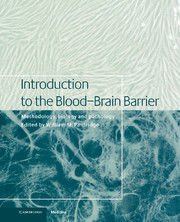Book contents
- Frontmatter
- Contents
- List of contributors
- 1 Blood–brain barrier methodology and biology
- Part I Methodology
- Part II Transport biology
- Part III General aspects of CNS transport
- Part IV Signal transduction/biochemical aspects
- Part V Pathophysiology in disease states
- 41 Cerebral amyloid angiopathy
- 42 Brain microvasculature in multiple sclerosis
- 43 Hemostasis and the blood–brain barrier
- 44 Microvascular pathology in cerebrovascular ischemia
- 45 HIV infection and the blood–brain barrier
- 46 Hypertension
- 47 The blood-brain barrier in brain tumours
- 48 The pathophysiology of blood–brain barrier dysfunction due to traumatic brain injury
- 49 Cerebral malaria and the brain microvasculature
- 50 Molecular basis of tissue tropism of bacterial meningitis
- Index
45 - HIV infection and the blood–brain barrier
from Part V - Pathophysiology in disease states
Published online by Cambridge University Press: 10 December 2009
- Frontmatter
- Contents
- List of contributors
- 1 Blood–brain barrier methodology and biology
- Part I Methodology
- Part II Transport biology
- Part III General aspects of CNS transport
- Part IV Signal transduction/biochemical aspects
- Part V Pathophysiology in disease states
- 41 Cerebral amyloid angiopathy
- 42 Brain microvasculature in multiple sclerosis
- 43 Hemostasis and the blood–brain barrier
- 44 Microvascular pathology in cerebrovascular ischemia
- 45 HIV infection and the blood–brain barrier
- 46 Hypertension
- 47 The blood-brain barrier in brain tumours
- 48 The pathophysiology of blood–brain barrier dysfunction due to traumatic brain injury
- 49 Cerebral malaria and the brain microvasculature
- 50 Molecular basis of tissue tropism of bacterial meningitis
- Index
Summary
Introduction
The cerebral blood vessels are important targets of disease in patients infected with the human immunodeficiency virus (HIV). Vascular abnormalities include direct infection by HIV or opportunistic organisms, alterations related to inflammation or gliosis in the brain, and changes secondary to abnormal cellular or serum components in the systemic circulation. Cerebral ischemia or hemorrhage are two of the consequences of such vascular changes. Of particular interest, however, are the changes in the blood–brain barrier (BBB) that occur in almost half of the patients with the acquired immunodeficiency syndrome (AIDS). This chapter summarizes the neuropathology and cerebrovascular pathology that occur in patients with AIDS, discusses the abnormalities in the BBB that develop in the absence of any apparent brain pathology, and reviews the potential mechanisms for, and the effects of, this enhanced vascular permeability.
Neuropathology of HIV infection and its relationship to the cerebral vasculature
Brain and spinal cord diseases are frequent in patients with AIDS (Petito et al., 1986; Sharer, 1992). Approximately 30% had HIV encephalitis with microglial nodules and either the multinucleated giant cells that are characteristic of HIV or HIV protein or genomic material at autopsy during the first decade of the HIV epidemic.
- Type
- Chapter
- Information
- Introduction to the Blood-Brain BarrierMethodology, Biology and Pathology, pp. 419 - 426Publisher: Cambridge University PressPrint publication year: 1998
- 2
- Cited by



